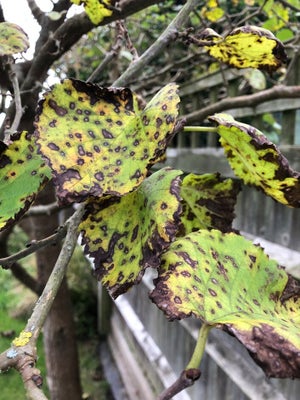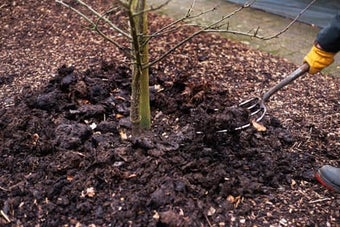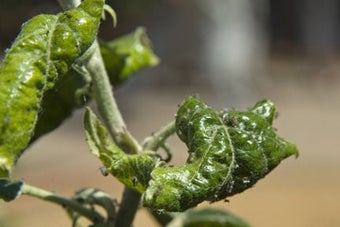
Quick facts
Common name - Mulberry leaf spot
Scientific name - Mycosphaerella mori (syn. Phloeospora mori)
Plants affected - Black Mulberry (Morus nigra) White Mulberry (Morus alba)
Main causes - Fungus
Timing - late spring, summer to early autumn, particularly in wet conditions
What is mulberry leaf spot?
Mulberry leaf spot is a fungal disease favoured by wet weather. The older wood of the tree is not affected, but the fruit crop yield can be reduced.
Severely-affected trees can suffer premature defoliation, but the disease has little long-term effect on the vigour of a mature tree. Repeated infection may delay the establishment of young trees, however.
Symptoms
You may see the following symptoms:
- Small, dark brown and irregular leaf spots with pale-green yellow haloes appear in the spring
- The spots increase in size, the centres becoming whitish and the haloes developing brown necrotic margins (dead edges)
- Tiny, brown–black, spore-producing fruiting bodies (acervuli) occur on the lesions and defoliation can occur after severe attacks

Control
Non-chemical control
Ensure that any leaves falling prematurely from an affected tree are collected and disposed of (by burning, burial or consigning to the council ), together with all the rest of the leaves when they fall in autumn. Good hygiene may prevent a noticeable level of the disease recurring in the future. The disease is favoured by wet weather so may also be less of a problem in drier summers.
Vigorous, healthy trees tend to be more resistant to attack. Young trees will benefit from feeding in spring and watering regularly in dry spells.
Some cultivars of Morus alba appear to be less susceptible to mulberry leaf spot. Morus alba ‘Pakistan’ is a variety with long black fruits and could be considered an unusual alternative. It requires a warm and sheltered site to perform well in the UK.
Fungicides
The RHS recommends that you don't use fungicides. Fungicides (including organic types) may reduce , impact soil health and have wider adverse environmental effects. If you do intend to use a fungicide, please read the information given in the link and download below to ensure that use, storage and disposal of the product is done in a responsible and legally compliant manner.
The products listed in the ‘Fungicides for gardeners’ document below are legally available for use by home gardeners in the UK. This information is provided to avoid misuse of legal products and the use of unauthorised and untested products, which potentially has more serious consequences for the environment and wildlife than when products are used legally. Homemade products are not recommended as they are unregulated and usually untested.
There is no specific information available on the efficacy of any home garden fungicide against mulberry leaf spot. Fungicides can only be used on mulberries if you have no intention of eating the fruit since there are currently no fungicides available for use by home gardeners on fruit crops for consumption.
Download
Fungicides for gardeners (Adobe Acrobat pdf document outlining fungicides available to gardeners)
Link
Other disease symptoms on mulberry leaves
Mulberry leaves can be affected by a number of other diseases but none is as common or as damaging in the UK as Mycosphaerella mori.
Bacterial leaf spot is caused by the bacterium Pseudomonas syringae pv. mori, producing numerous small, angular, black leaf spots, often with a yellow halo (see photo 3 in the gallery above). Whole leaves may turn yellow and the vigour of the tree may be compromised. Elongated black lesions may occur on the stems. Oozing bacterial slime may be visible in wet weather causing dieback of the shoots. The affected shoots should be cut out and burned. Fallen leaves should be collected and disposed of (by burning, burial or consigning to the council ), together with the rest of the leaves when they fall in the autumn.
is not seen commonly on mulberries but where it occurs it affects both black and white mulberries. It is a fungal disease of the foliage initially covering the leaf surface, visible as a white powdery coating particularly on the underside of the leaf. Destroying fallen leaves in autumn should reduce the amount of infectious spores produced the following spring. Pruning out any infected shoots will reduce subsequent re-infection. Managing the environment around susceptible plants can help to reduce the occurrence of powdery mildew. Plant in full sun where possible and aim for an open environment to increase air circulation and reduce . Providing good drainage and watering regularly in dry periods will reduce the likelihood of powdery mildew infection.
Further details on powdery mildews and their management can be found in our advice profile on this link. Remember that any fungicides mentioned can only be used on mulberry trees grown as ornamental specimens.
Biology
Mulberry leaf spot is caused by the fungus Mycosphaerella mori and fluctuates in severity from year to year, being most damaging in wet summers.
The fungus can overwinter in young parts of branches, and in fallen leaves lying on the ground. In spring, sexual spores (ascospores) are produced from tiny fruiting bodies produced on the fallen leaves, and these spores are carried upwards in the air to infect the new spring growth. Spores can also be produced in spring from the lesions on the branches. Once leaf spots have developed, splash-dispersed asexual spores (conidia) are produced from them to spread the disease further. Transmission is therefore favoured by wet weather, both to disperse the spores and to provide the several hours of leaf wetness required for spore and infection.




